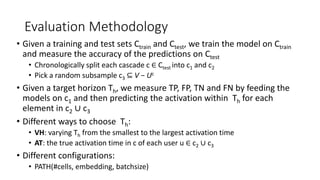Temporal Recurrent Activation Networks
- 1. Temporal Recurrent Activation Networks Giuseppe Manco, Giuseppe Pirrò, Ettore Ritacco ICAR-CNR, Rende (CS)
- 3. Motivation and Background • Abundance of streaming data • sequences of events characterized by the time in which they occur • Diffusion processes crucial in many domains • Diagnostic events (medical records, predictive maintenance, process optimization) • Consumer behavior (purchasing patterns) • “Quantified self” data (wearable devices and apps to record eating, traveling, working, sleeping, waking) • smart cities and mobility patterns (trajectories, taxi/car/public transportation adoptions). • Social media actions (previous posts, shares, comments, messages)
- 4. Information Cascades • Information propagation in social networks • Cascade: a subgraph tracking propagation trace (a) Facebook shared link (b) Twitter retweet (a) A social graph Importance of Cascades a) Viral marketing b) Recommendation c) Information Security (b) A cascade The graph can be implicit!!!
- 5. Information Cascades •The cascade structure is partially observed #iPhone5 Alice, 1pmBob, 1:50pm Cooper, 3pm DavidEd Frank Alice, 1pm Bob, 1:50pm Cooper, 3pm
- 6. Information Cascades • Challenge: predict the cascade evolution based on its partial observation Identify factors that can shape the cascade structure
- 7. Issues •Events can be boosted or prevented by the occurrence of other events •The factors governing activations and their dependency from times are hidden • Stimulus provided by the ego-network of a user or his attention/propensity towards specific themes • Susceptibility of users: the extent to which they are influenced by specific previously activated users
- 8. Cascade Features (u1 ,t1) (u4 ,t4) (u5 ,t5) (uk ,tk) (u2 ,t2) (u7 ,t7) (u3 ,t3) (uj ,tj) (u4 ,t4) (u5 ,t5) (u1 ,t1) (uf ,tf) c1 c2 cm …………………… 𝛿0=0 𝛿1=(t1-t0) 𝛿k=(tk-tk-1)𝛿2=(t2-t1) u1 t1 𝛿1 u4 𝛿4 t4 u5 t5 𝛿5 uk tk 𝛿k f1 u2 t2 𝛿2 u7 𝛿7 t7 u3 t3 𝛿3 uj tj 𝛿j u4 t4 𝛿4 u5 𝛿5 t5 u1 t1 𝛿1 uf tf 𝛿f f2 fm ……………………
- 9. Problem statement, by examples
- 10. PATH: Basic Intuition • Given a partial observed cascade: • predict whether one or more target users will become active in the cascade within a time horizon Th • PATH learns an embedding of the past event history via Recurrent Neural Networks that also cater for the diffusion memory • the embedding captures influence and susceptibility between users • (the representation of) users that frequently become active in different streams within a small time interval are closer
- 11. PATH: Modelling Diffusion •Density Function: •Likelihood that u becomes active within t, given the current history Hc <t •Likelihood that u activates (independent of time) as a reaction to the current history
- 12. PATH: architectural overview Layer of Long Short Term Memory cells 𝑦
- 13. The (not so) complex math behind the model…
- 14. Evaluation Methodology • Given a training and test sets Ctrain and Ctest, we train the model on Ctrain and measure the accuracy of the predictions on Ctest • Chronologically split each cascade c ∈ Ctest into c1 and c2 • Pick a random subsample c3 ⊆ V − Uc • Given a target horizon Th, we measure TP, FP, TN and FN by feeding the models on c1 and then predicting the activation within Th for each element in c2 ∪ c3 • Different ways to choose Th: • VH: varying Th from the smallest to the largest activation time • AT: the true activation time in c of each user u ∈ c2 ∪ c3 • Different configurations: • PATH(#cells, embedding, batchsize)
- 15. Evaluation Setting • Prediction capability of PATH on • cascades crawled from the timelines of Twitter and Flixster • PATH against different models: • Cox proportional hazard model with fixed horizon: Cox (FH) • Cox proportional hazard model actual time: Cox (AT) • Survival factorization (SF)
- 18. Conclusion • Predicting user activations in a given time horizon embedding of the user activation history • Can be effectively learned via recurrent neural networks • Challenge • How to cast the intuitions behind our approach in a generative setting • In particular, to predict the effective time instant upon which she will become active
Editor's Notes
- #9: Current approaches: Predict the next user Predict the next user and the exact activation time This requires to provide activation probabilities for each node in the network not yet active Other weakness
- #10: Current approaches: Predict the next user Predict the next user and the exact activation time This requires to provide activation probabilities for each node in the network not yet active Other weakness



















